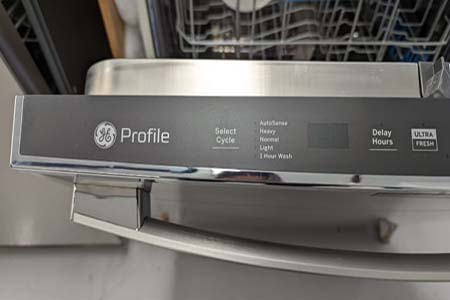In this article, you’ll learn how to reset a dishwasher, how to do it safely, avoid common mistakes, and what to do after resetting. We’ll also cover important maintenance tips to keep your dishwasher running smoothly.

Safety Precautions
Before diving into the reset process, it’s crucial to prioritize safety. Dishwashers are electrical appliances, and working on them can pose risks. Here are some essential safety precautions to follow:
- Turn Off Power: First, unplug your dishwasher from the power source. You can do this by unplugging the device or turning off the circuit breaker that supplies power to the device. This step is crucial to prevent electrical accidents during reset.
- Gather Necessary Tools: Depending on your dishwasher’s make and model, you may require specific tools or information for the reset. Having your dishwasher’s user manual on hand is essential, as it often contains valuable instructions for resetting the appliance. Additionally, consider having tools like a multimeter if your reset involves electrical components.
Common Resetting Mistakes to Avoid
While resetting a dishwasher is a straightforward process, there are common mistakes that you should avoid:
- Overlooking Safety Precautions: Always prioritize safety. Failing to disconnect the power source before attempting a reset can lead to electrical hazards.
- Incorrect Reset Sequence: It’s essential to follow the correct reset sequence as per your dishwasher’s user manual. Pressing the wrong buttons or performing the reset out of order can be ineffective.
- Ignoring Error Codes: Many modern dishwashers display error codes to indicate specific issues. Ignoring these codes during a reset can result in recurring problems. Take note of any error codes and consult your user manual for guidance.
Dishwasher Reset Problem Resolution
Basic Reset Steps
Performing a basic dishwasher reset is often a straightforward process. The exact steps may vary depending on your dishwasher’s brand and model, but here’s a general guide to help you get started:
- Start with an Empty Dishwasher: Make sure your dishwasher is empty and free of dishes, utensils, or debris.
- Turn Off Power: As mentioned earlier, unplug the dishwasher from the power source for safety reasons. earlier, disconnect the dishwasher from the power source to ensure safety.
- Wait for a Few Minutes: Sometimes, allowing the dishwasher to sit without power for a few minutes can help reset its internal systems.
- Reconnect Power: Reconnect the dishwasher or turn on the circuit breaker.
- Select a Reset Option: If your dishwasher has a reset button or a specific reset cycle, follow the manufacturer’s instructions to initiate the reset.
- Wait for Completion: Allow the dishwasher to complete the reset cycle. This may take a few minutes, during which the dishwasher will go through a sequence of actions.
- Test the Dishwasher: After the reset cycle is complete, run a test cycle to ensure that the dishwasher is functioning correctly. Pay attention to any error codes or unusual behavior.
Post-Reset Verification
After performing the reset, it’s essential to verify whether it was successful:
- Checking the Reset: Ensure that the reset process was completed without any interruptions. If the dishwasher displays any error codes during or after the reset, take note of them for reference.
- Testing the Dishwasher: Run a short cycle with a few dishes to test the dishwasher’s functionality. Pay attention to the entire cycle, from filling and washing to draining. Confirm that the dishwasher is working as expected.
Maintaining Your Dishwasher
Preventing future issues is just as crucial as fixing current ones. cleaning and maintenance can help extend your dishwasher’s lifespan and keep it running smoothly. Here are Regular some maintenance tips to consider:
- Regular Cleaning: Clean the interior of the dishwasher, including the spray arms, filter and door seal to prevent the buildup of residue and debris.
- Proper Loading: Avoid overloading the dishwasher, as overcrowded dishes can obstruct water flow and affect cleaning performance.
- Choosing the Right Detergent: Select a high-quality dishwasher detergent and use the correct dosage to prevent excess suds and residue buildup that can affect performance.
By being aware of the need for a dishwasher reset, following safety precautions, performing the reset correctly, and maintaining your dishwasher, you can ensure that it continues to serve you well and provide flawless, hassle-free cleaning for years to come enabled.